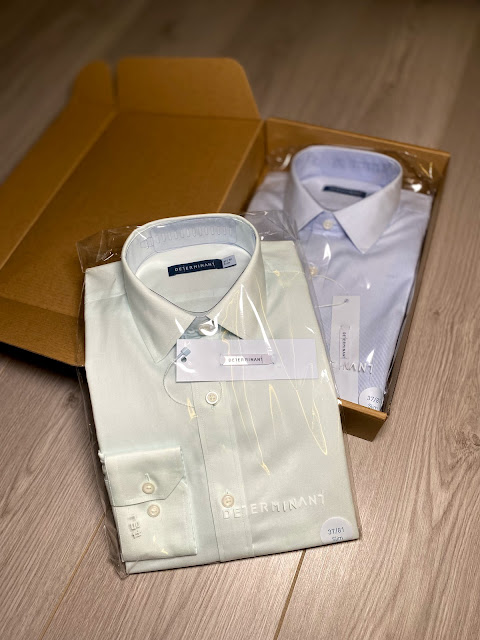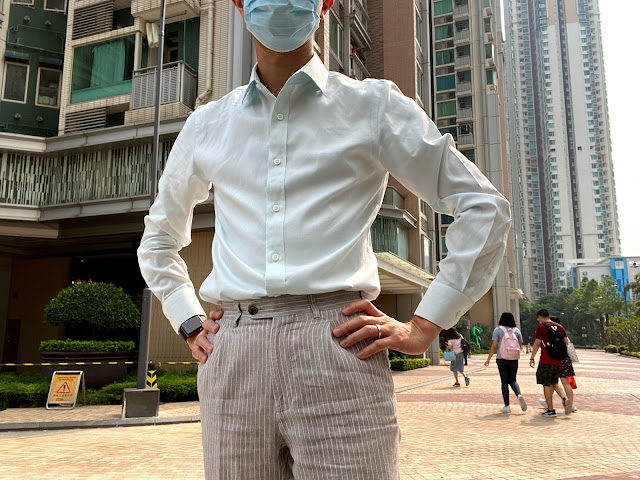 |
| DETERMINANT "All-Occasion Point Collar Smart Shirt" (light blue) |
Long story short: once @shirtingfantasy discovered the practical benefits of high-count (say, 170/2, 200/2 or even 300/2) cotton shirts, he found it a bit difficult to go back to 100/2 and below - simply because the "skin-feel" is so different.
What are the practical benefits we are talking about?
(1) High-count cotton shirts are cooler
Shirt fabric (aka shirting) usually have only one layer - the finer the yarns, the thinner the fabric. This is why a 200/2 poplin is thinner than a 80/2 poplin, and is somewhat similar in thickness to a 100/1 poplin.
The first number here refers to the diameter of the yarn, in a unit called New English Count (Ne). A bigger number means a finer yarn. The second number means the number of "plys" - basically how many yarns are twisted together to form the actual one used to weave your fabric.
Do not make the mistake to think that "high count fabric doesn't let air through and you will suffocate in your shirt". Yarn count is NOT the number of yarns per inch or cm. The technical term for that is called weft and warp count / density, for the lengthwise and widthwise directions of yarns, respectively.
(2) High-count cotton shirts dry quickly
A thinner cloth dries faster than a thicker cloth of the same material and weave - usually - if only because the latter holds more water per unit area.
While I am not entirely sure about how capillary actions operate to affect evaporation in this context, I would tend to think that thickness is the most important determining factor in determining how fast your shirt would dry - compared to something of the same material and finishing.
(3) High-count cotton shirts from quality fabric is surprisingly durable
Let's make things clear: finer yarns are less durable (simple logic), but luxury shirt fabric often use 2x2 construction (both weft and warp being two-ply) - which usually offsets any degradation in durability due to a finer yarn per se. While cotton, wool, and polyester cannot be considered "equal", with proper consideration of this limitation in mind, we may take reference from a contemporary study on yarn-ply and weave pattern on durability and other properties of a woven cloth -
"It seems that for all weave structures, abrasion resistance of yarns is as follows: two-ply ring > Solo >Siro > single-ply ring"
"Two-ply ring-spun yarn consists of two single-ply yarns that passed the doubling and second twisting after the first stage of twisting. These processes improve the fiber trapping in the yarn structure. However, single-ply yarn has lower abrasion resistance because of the loose structure and low yarn compactness; therefore, the yarn’s structure is easily destroyed after facing the abrasive forces."
- in Tahvildar, Ali, Nazanin Ezazshahabi, and Fatemeh Mousazadegan. "Appearance and comfort properties considering yarn-spinning system and weave structure in worsted woven fabrics." Journal of Engineered Fibers and Fabrics 14 (2019): 1558925019845978.
So, while a 200/2 x 200/2 fine DJA poplin is likely less durable than a casual 80/2 x 80/2 Oxford (yes - you do have two-ply Oxford cotton from Alumo), it may not be worse than the 100/1 x 100/1 fabric that is used to make your HKD 1,000 / 3 shirt "value bespoke".
But now @shirtingfantasy is ignoring all these. In the limiting case which we cannot - or do not want to - spend HKD 500 on Thomas Mason fine cotton, HKD 300 just for the making of the shirt, or both, certain trade-offs have to be made (e.g. smooth and soft hand of the fabric, comfort, absolute durabiliy). To view this from a more holistic perspective, the user of budget shirts would also likely benefit also from the ease of care / low maintenance of a practical shirt.
So here it goes: I bought a total of five shirts from the Esquel Group-owned brand DETERMINANT (two at the Moko pop-up store with 15% off, three more online with a not-so-secret discount code with an even better discount). I washed, worn (without ironing), and repeated the cycle for one of the shirts to see how the wrinkle-free treatment performs:
 |
| Before the first wash |
 |
| After the first wash |
 |
| After the second wash |
 |
| DETERMINANT Wrinkle-Free Dress Shirt in mint green |
- Shirts are wearable right after wash and tumble dry, and they do not crease a lot with normal daily wear.
- The fabric is not sheer, not the coolest, but is bearable in Southern China in Summer (read: 30°C, RH 70%). The fabric (both their poplin and pinpoint Oxford) also has a delightful soft hand and is absorbent. The "plastic feel" is minimal despite the anti-wrinkle treatment.
- The fabric has a slight stretch (as advertised). That is something I really like.
- The colours are not the greatest. The white has a yellow tint, the blue is greyish, and mint green (as seen in above photo) looks like bleached and lacking in saturation. Overall the colours are muted and not attractive.
- The claim of "80/2 yarns" is tricky. If one looks at their Taobao store one can see that they are cutting corners by using 80/2 x 40/1 construction. As evident from discussions above, the only consideration can only be cost compression.
- The collars are quite small and do not spread wide enough. The claim that they "use a spread collar design on our dress shirts... looks good whether you wear the shirt with or without a tie" is only partly true. It actually looks better without a tie, or only with a very narrow tie / tiny knot.
- Buttons are plastic. Like it or not, I consider it more practical for shirts in this price range.
- It was not possible to evaluate whether the fabric is pure cotton (without even 1-2% of Lycra or Spandex), or indeed resists bad odour due to bacterial growth as claimed (I did not wear the shirts continuously).
DETERMINANT shirts
https://shop.detshirts.com
Minimum order: 1 shirt
Price range: HKD 358 (short sleeves), HKD 398 (normal dress shirts), or HKD 498 (anti-viral claim). Discount codes here and there.
MTR Floor Atrium A, MOKO
Mong Kok East
MTR Station Exit D

" High-count cotton shirts are cooler"
ReplyDeleteI thought cooler fabric like linen or seersucker almost always has a super low count?
(1) Linen - because the yarns tend to be quite thick (“low count”)
Delete(2) Seersucker - the surface structure avoids the fabric from sticking to one’s skin
Looking for half shirt. Discover our collection of men's formal shirts at TheShirtFactory, where classic sophistication meets contemporary style.
ReplyDeleteLooking for cotton shirt for men. Discover our collection of men's formal shirts at TheShirtFactory, where classic sophistication meets contemporary style.
ReplyDeleteAustin Trim is an easy and online manufacturing platform that meets the needs of apparel manufacturers, boutiques, cut & sew apparel & street wear brands
ReplyDeleteAustintrim
Smart shirts like this blend versatility and style effortlessly. For more customisable options in every shade and fit, check out our tailored shirt range.
ReplyDelete